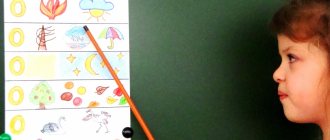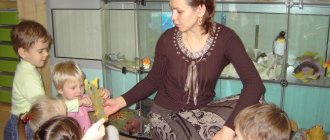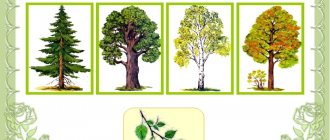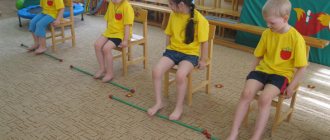Childhood
The time of childhood is that wonderful time when the necessary knowledge and skills are laid that determine our future. Speech education of children is of great importance for their successful socialization in society and the formation of a successful personality.
In kindergarten, teachers face a number of important educational and educational tasks, the most important among which is teaching the native language, developing coherent speech, laying the foundations of grammar and preparing for literacy.
I address my texts on pedagogical topics, first of all, to parents for whom it is important to understand their role in the life of a child. Although educators and teachers work to give your children everything they need in terms of personal development, only you, mom and dad, are responsible for the child’s future. Don't rely on kindergarten and school. No one will give your children more than their parents can give.
This also applies to speech and thinking activity, about which I write so much. Engage with your children, devote time to them and it will come back to you a hundredfold. You deposit knowledge as a deposit in a bank, and then you can receive a solid dividend in the form of your child’s success. Don’t have time to devote even half an hour to studying? Then call your child into the kitchen, cook borscht together, comment on your actions along the way and ask your child questions.
Just chat to your heart's content! Don’t waste time, teach your children to actively communicate with you, let them talk, share their impressions, problems, and fears with you.
How to help a child master his native speech perfectly?
It's funny, but we study foreign languages, but we have no idea about the richness of our native language. Our speech is often primitive, we often use cliches, replace an entire sentence with one interjection “Wow!” Is it any wonder that our children cannot speak in complete, literate sentences?
Children aged 3-4 years are just learning dialogical speech; they are beginning to master the ability to coherently express their own thoughts. The children gradually complicate their sentences by using subordinate constructions such as “because..., when...”
The volume of vocabulary reaches 2.5 thousand words, but in speech the children make many mistakes when constructing sentences, describing the quality of the subject, etc. Now is the time to widely use adjectives denoting the characteristics of an object and the quality of an action. It's time to make the first conclusions, conclusions and generalizations.
If in the younger group we encourage children to perform certain actions according to the teacher’s words (please bring a toy; draw a sun), then the middle group is already learning to answer and ask questions, listen to the teacher, and repeat after him.
To ensure your child’s success in understanding the basics of dialogic speech, ask questions specifically, understandably, and age-appropriate: What is your name? What color is the bunny? What toy do you like?
In the same way, we ask you to briefly and specifically tell us about something: tell us about your toy. And we help with leading questions: what is it, what color, what size.
Grasping the meaning of a child’s statement, trying to understand it, I, as a teacher, try to encourage children to talk to me, ask for something, tell me. By cutting off the desire to speak out with your comments, impatience, and criticism, you will “shut your child’s mouth” for a long time.
Features of the development of speech in the middle group lie in two directions: independent storytelling and retelling. Starting with the simplest plot, the children learn to gradually build more complex speech structures.
Development of coherent speech in middle preschool age article on speech development (middle group)
Development of coherent speech in middle preschool age
The most important, final link in the holistic system of teaching preschoolers their native language is the development of coherent productive speech, i.e. speech as a means of communication between a child and adults and other children. The main characteristics of coherent speech are its content, logic, consistency, and understandability for the interlocutor.
Oral speech, which preschoolers master, comes in two main forms: dialogue and monologue. They differ from each other in their communicative orientation, linguistic and psychological nature. Dialogue does not require detailed sentences, because their content is supplemented by facial expressions, gestures, intonation, as well as the situation. In a monologue, on the contrary, relatively little is used of non-speech information arising from the conversation situation. So, instead of pointing to an object, in a monologue they name it, and, if necessary, give its description.
Monologue speech is more complex than dialogue. Dialogical speech is stimulated by both internal and external motives (situation, remarks of the interlocutor). Monologue speech is stimulated by internal motives; its content and linguistic means are chosen by the speaker himself.
Requirements for children in speech activity:
Meaningfulness, i.e. full understanding of what they are talking about; — completeness of transmission, i.e. absence of significant omissions that violate the logic of presentation; - subsequence; - wide use of vocabulary, phrases, synonyms, antonyms, etc.; — correct rhythm, absence of long pauses; - culture of presentation in the broad sense of the word: - correct, calm posture when speaking, addressing listeners, - intonational expressiveness of speech, - sufficient volume, - distinct pronunciation.
In middle preschool age, children are taught to willingly enter into communication with adults and peers, answer and ask questions about objects, their qualities, actions with them, relationships with others, and support the desire to talk about their observations and experiences.
The teacher pays more attention to the quality of the children’s answers: he teaches them to answer both in a short and in a common form, without deviating from the content of the question. Gradually, he introduces children to participate in collective conversations, where they are required to answer only when the teacher asks, and listen to the statements of their comrades.
The cultivation of a culture of communication continues: the formation of the ability to greet relatives, friends, group mates, using synonymous etiquette formulas (Hello! Good morning!), answer the phone, not interfere in the conversation of adults, enter into conversation with strangers, greet a guest, communicate with him.
In the middle group, children retell the contents of not only well-known fairy tales and stories, but also those that they heard for the first time. When telling stories based on a picture and a toy, children first learn to construct statements of a descriptive and narrative type. Attention is drawn to the structural design of descriptions and narratives, an idea is given of the different beginnings of stories (“Once upon a time,” “Once upon a time,” etc.), and the means of connection between sentences and parts of a statement. The adult gives the children the beginning and offers to fill it with content, develop the plot (“Once upon a time... animals gathered in a clearing. They began... Suddenly... The animals took it... And then...").
It is necessary to teach children to include in the story elements of descriptions of characters, nature, dialogues of the characters in the story, and to accustom them to the sequence of storytelling. By the end of the year, children, with the help of the teacher, are able to compose a story based on a series of plot pictures: one child tells one picture at a time, the other continues, and the teacher helps to connect the transitions from one picture to another (“And then”, “At this time”, etc.). P.).
With systematic work, children can compose short stories from personal experience, first based on a picture or toy, and then without relying on visual material.
Methods of working on the formation of coherent speech.
1. Conversation with a child using colorful pictures, expressive intonation, facial expressions, and gestures.
2. Reading stories or fairy tales.
An adult can ask questions about the content of the story to find out the child’s understanding of cause-and-effect relationships (Why did this happen? Who is to blame for this? Did he do the right thing? etc.) An understanding of the meaning of the story is also evidenced by the ability to retell it in your own words.
3. Conversation (dialogue).
You can talk about various topics: about books, films, excursions, and it can also be conversations based on pictures. The child must be taught to listen to the interlocutor without interrupting, to follow his train of thought. In a conversation, an adult’s questions should gradually become more complex, just like the children’s answers. We start with specific questions that can be answered with one short answer, gradually complicating the questions and requiring more detailed answers. This is done with the goal of a gradual and imperceptible transition to monologue speech for the child.
An example of a “complicated” conversation.
- What animals do you see in this picture? - A wolf, a bear and a fox. -What do you know about the wolf? - He is gray and angry and lives in the forest. He also howls at night. - What can you say about the bear? “He’s big, brown, and spends the winter in a den. - What do you know about the fox? “She’s very cunning, red-haired and has a big fluffy tail.” -Where did you see these animals? — In the zoo, where they live in cages. - What fairy tales do you know about a bear, a fox, a wolf? and so on.
4. Writing a descriptive story.
The child masters the first skills of coherent presentation of thoughts “on one topic”; at the same time, he learns the characteristics of objects, and, consequently, his vocabulary expands. To enrich vocabulary, it is very important to carry out preparatory work for compiling each descriptive story, reminding the child of the characteristics of the objects being described. First, describe individual objects, and then move on to comparative descriptions of homogeneous objects, learn to compare animals, fruits, vegetables, trees, etc.
An example of writing a descriptive story using a diagram.
5. Compiling a story based on a series of plot pictures.
The number of story pictures in the series gradually increases, and the description of each picture becomes more detailed, consisting of several sentences. As a result of compiling stories based on a series of pictures, the child must learn that stories must be built in strict accordance with the sequence of pictures, and not according to the principle “Whatever comes to mind first, talk about that.”
Examples of a series of plot pictures.
6. Compiling a story based on a plot picture.
When composing a story based on one plot picture, it is very important that the picture meets the following requirements:
— it should be colorful, interesting and attractive for the child; - the plot itself should be understandable to a child of this age; - there should be a small number of characters in the picture; - it should not be overloaded with various details that are not directly related to its main content.
It is necessary to invite the child to come up with a name for the picture. The child must learn to understand the very meaning of the event depicted in the picture and determine his attitude towards it. First, the adult must think through the content of the conversation based on the picture and the nature of the questions asked of the child.
Examples of plot paintings:
7. Retelling.
In the process of working on a retelling, the child develops and improves attention and memory, logical thinking, and an active vocabulary. The child remembers grammatically correct figures of speech and patterns of speech construction. Introducing a child to new information contained in stories and fairy tales expands the range of his general ideas and contributes to the improvement of his monologue speech as a whole.
When working on a retelling of a specific text, you first need to expressively read or tell the child a story that is interesting and accessible to him in content and then ask if he liked it.
You can also ask a few clarifying questions about the content of the story. It is imperative to explain to your child the meaning of unfamiliar words. It is important to pay attention to “beautiful” turns of phrase. You can look at the illustrations. Before re-reading the story, invite your child to listen to it carefully again and try to remember it, and then retell it close to the original.
It is important to train your child in other types of retelling:
— Selective retelling. It is proposed to retell not the entire story, but only a certain fragment of it.
— Brief retelling. It is proposed that, by omitting less significant points and without distorting the general essence of the story, we correctly convey its main content.
— Creative storytelling. The child needs to add something new to the story he has heard, to bring something of his own into it, while showing elements of fantasy. Most often, it is suggested to come up with a beginning or an end to the story.
— Retelling without relying on visuals.
When assessing the quality of a children's retelling, it is important to consider the following criteria:
— completeness of the retelling; — sequence of presentation of events, compliance with cause-and-effect relationships; - the use of words and phrases of the author’s text, but not a word-for-word retelling of the entire text (retelling “in your own words” is also very important, indicating its meaningfulness); - the nature of the sentences used and the correctness of their construction; - absence of long pauses associated with the difficulty of choosing words, constructing phrases or the story itself.
8. Compiling your own story.
The transition to independent compilation of stories should be fairly well prepared by all previous work, if it was carried out systematically. Most often these are stories from the child’s personal experience. A story from personal experience requires the child to be able to independently select the right words, construct sentences correctly, and also determine and retain in memory the entire sequence of events. Therefore, children’s first small-scale independent stories must necessarily be associated with a visual situation. This will “revive” and complement the child’s vocabulary necessary for composing a story, create an appropriate internal mood in him and allow him to more easily maintain consistency in describing the events he has recently experienced.
Examples
"Paint a picture with words"
Goal: to develop imagination, the ability to use words and figurative expressions that are accurate in meaning in the description.
Equipment: a poem about spring (summer, winter, etc.).
Progress of the game:
An adult addresses the children: “Do you want to become extraordinary artists who draw not with paints and pencils, but with words? Then get ready to draw.
I will read you a gentle poem about spring, and you close your eyes and try to imagine what I will read about. Then tell us what kind of picture you got. But you need to tell it in such a way that everyone can mentally see your picture.”
Children can then paint illustrations for their stories.
"Come up with a fairy tale"
Goal: independently select expressive means to compose a fairy tale or story on a given topic.
Equipment: picture with a winter landscape (spring, summer, autumn, etc.).
Progress of the game:
The teacher offers to compose a fairy tale “What trees dream about in winter” for children after they look at a picture of a winter landscape and hear a poem or story about the first month of winter.
"Magic bag"
Goal: to develop the child’s speech, teach children to describe an object, and learn the endings of nouns in the dative case.
Equipment: bag with toys: vegetables, fruits, berries, sweets.
Progress of the game:
An adult takes a picture out of the bag and says: “Here is cabbage. What is she like? Who will we give it to?” The child tells what cabbage is like and who likes to eat it.
One is many
Goal: to consolidate various types of endings of nouns in children’s speech.
Progress of the game:
“We are little wizards: there was one, but there will be many.” An adult names singular nouns. Children name nouns in the plural.
| table - tables | piece - pieces |
| chair – chairs | day - days |
| mountain - mountains | jump - jumping |
| leaf – leaves | yard - courtyards |
| house - houses | feather - feathers |
Generalizing concepts
Goal: expansion of vocabulary through the use of generalizing words, development of attention and memory, ability to correlate generic and specific concepts.
Progress of the game:
The adult names a generalizing concept. The child must name objects related to that generalizing concept.
| Adult | Children |
| Vegetables | potatoes, cabbage, tomato, cucumber, radish. |
| Berries | raspberries, strawberries, blackberries, watermelon, blueberries. |
| Trees | birch, spruce, pine, oak, linden, poplar, walnut. |
| Pets | cow, horse, goat, sheep, rabbit, ram, cat, dog |
| Migratory birds | swift, swallow, rook, starling, stork, heron, crane |
| Wintering birds | dove, crow, magpie, sparrow, woodpecker, owl |
| Furniture | chair, table, armchair, sofa, wardrobe, bed, sofa |
| Dishes | plate, spoon, fork, knife, teapot, cup, saucer |
Who lives where?
Goal: to consolidate children’s knowledge about the homes of animals and insects. Consolidating the use of the grammatical form of the prepositional case with the preposition “in” in children’s speech.
Progress of the game:
The adult asks the children a question one by one, and they answer. It is necessary to monitor the correct use of prepositions.
| Adult | Children |
| Who lives in a hollow? | Squirrel |
| Who lives in a birdhouse? | Starlings |
| Who lives in the nest? | Birds: swallows, cuckoos, jays |
| Who lives in the booth? | Dog |
| Who lives in the hive? | Bees |
| Who lives in the hole? | Fox |
| Who lives in the den? | Wolf |
| Who lives in the den? | Bear |
Fourth wheel
Goal: to consolidate children’s ability to identify common features in words and develop the ability to generalize.
Progress of the game:
An adult names four words and asks them to determine which word is the odd one out.
For example:
blue, red, green, ripe. Zucchini, cucumber, pumpkin, lemon. Cloudy, stormy, gloomy, clear.
Fun account
Goal: to consolidate the agreement of nouns with numerals in children’s speech.
Progress of the game:
The adult pronounces a combination of a noun with the numeral “one”, and the child in response calls the same noun, but in combination with the numeral “five”, “six”, “seven”, “eight”.
Example:
| One table – five tables | One chicken - five chickens |
| One elephant - five elephants | One hare - five birds with one stone |
| One crane – five cranes | One hat - five hats |
| One swan - five swans | One can – five cans |








